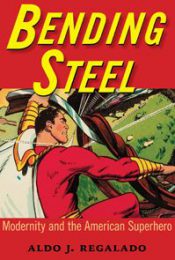By examining interviews, trade magazines and even testimonies, letters, memoirs and other personal data author Regalado seeks direct impact of the superheroes on the real lives of actual people. Or rather, he aims to find out just how “the big forces of American modernity shaped the lives of Americans on an individual level and how these individual responses were articulated through culture industries to shape and reshape mainstream notions of American identity.”
 So a number of traditional American pre-comic book heroes, such as Natty Bumppo and the dime novel heroes with a working-class background, are recalled, while the role of the superhero is deconstructed by taking away most of its ingredients that are deeply rooted in western (and American) folktales and urban legends. And until the early 20th century the characters reaffirm white (middle class and working class) masculinity and competitive spirit.
So a number of traditional American pre-comic book heroes, such as Natty Bumppo and the dime novel heroes with a working-class background, are recalled, while the role of the superhero is deconstructed by taking away most of its ingredients that are deeply rooted in western (and American) folktales and urban legends. And until the early 20th century the characters reaffirm white (middle class and working class) masculinity and competitive spirit.
This outlook changes with the advent of industrialization and new fictional heroes who simply escape technology and modern machinery, as the example of Tarzan shows. The writings of H. P. Lovecraft, then the foremost author of Gothic and horror tales, also had a strong influence on what was soon to become a comic and superhero culture in the 1930s.
Regalado in his two main chapters argues that with the beginning of modernity the superhero showed ways to live in a modern word that was then consistent of skyscrapers, industrial parks, extremely powerful and fast machines, and everything modern science had to offer: from dreaded weapons to new means of communication.
The inventors of the superhero comic, Americans with a mostly Jewish immigrant background, approached American reality with a very different set of experiences, compared to a mostly Anglo-Saxon group of authors that composed earlier heroic fiction. With Superman, an immigrant himself, this new outlook finally took shape. Even though he was white, he altered the racial and ethnic requirements for (super)hero stardom.
The final two chapters arrive at a historical point with a massive decrease in superhero comics sales after WWII set in. What followed some ten years later and finally revived the superhero were incidents like Marvel’s smart marketing ideas of conforming to current social events and very close interaction with comic book fandom culture. It lead to the revival of long-forgotten characters, now properly altered, together with stories adapted particularly to the needs and messages of the juvenile fans and the counter culture movement with its critique of American society in the 1960s, argues Regalado.
Naturally, some of Marvel’s new superheroes were individuals who were particularly aware of the dangers of nuclear weapons, gamma rays and more or less anything having to do with the military-industrial complex; the most prominent characters then were the Fantastic Four and the Incredible Hulk. Both the Hulk and the Thing are monsters and their superhero powers are the result of large-scale accidents with either atomic warfare research or cosmic rays.
Regalado sees the success with younger readers in this detail: differing appearance and individuality, seemingly feared by those of mainstream culture, worked as means of identification with those heroes. And it mirrored the young reader’s fear of the dangers of nuclear power and warfare, that had so dramatically altered their superhero’s lives.
This fan attention furthermore had an impact on the comic book artists, who slowly changed into entrepreneurs and self-confident creators who regained parts of control over at least some aspects of their output. Until the late 1950s, the artist usually had to sell the entire rights over to the companies.
All in all, there is a lot to find in Bending Steel, for the comic book fan as well as for the student of sociology. Since the focus is on the way American consumers and loyal fans perceived and experienced their own fandom culture – supported by comic book fanzines as Alter Ego and countless letters to DC and Marvel Comics – their own efforts had an impact on the changing style and messages of the superheroes. So there is a mutual reaction at work for comic books helped to understand American society and vice versa.
Aldo Regalado is a teacher of history and American studies.
Review by Dr. A. Ebert © 2016
Aldo J. Regalado. Bending Steel. Modernity and the American Superhero. University Press of Mississippi, 2015, 288 p.
